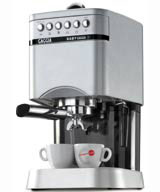Take your best shot
The latest breed of espresso machine has taken the grind out of making a top quality cup of coffee at home. John Cooper tests the Gaggia Baby D

There’s more to coffee than Starbucks. The chain may have turned the civilised world on to proper coffee, which can only be a good thing, but its insipid espresso will never satisfy the connoisseur.
I’m a coffee snob. If you ask me, a good espresso is the best measure you can put in a shot glass, hot or cold. This preference renders me a virtual pariah in London’s booze-addled social scene – who wants to hang out with a freak who would rather drink coffee than vodka?
Espresso machines are now so user-friendly that if you buy the right beans, the coffee you make at home will soon surpass anything offered at a commercial café chain. Gaggia’s Baby D, created by Rezzonico Design, is actually a behemoth compared to my humble machine, the starter model Gran Gaggia. My Gran Gaggia is three years old and I use it on average twice a day. That’s a lot of mileage, and I don’t expect it to compete with the Baby D, which sells for £299 – three times what I paid for mine.
Push the starter button and Baby D lights up like a caffeine-fuelled Tardis. I fill the tank with water, wait for the green light (which on other models means the machine is at operating temperature) and hit the button under the cute double espresso icon.
The result? Disappointing. The crema, the golden froth that is a key characteristic of a good espresso shot, is virtually absent. It is a smooth cup of espresso, although a little watery. The next cup was better. A little more crema, but it still lacked the rich texture I can achieve with my inferior model. Cappuccinos? A breeze. Actually, more like a tropical tornado. There’s some serious steaming power at your disposal, but I couldn’t quite figure out how to make the dense, fluffy froth found in a fine cappuccino.
I tighten the ice cream scoop-shaped device that holds the coffee and pack a few more grounds into it. The Baby D responds beautifully, producing a velvety coffee with a rich crema. Take out the scoop and the coffee grounds are completely dry – this machine limits the amount of water forced through them, so the coffee tastes better and it produces less mess when you empty out the used grounds.
At quite a steep price, Gaggia has dumbed-down the espresso making process, so consumers can enjoy espresso immediately, without experimentation. This is an understandable ploy in the face of competition from greedy global fmcg brands such as Procter & Gamble, Kraft and Sara Lee, which are producing wasteful pellet machines that, of course, only take their brand of coffee.
A traditional machine allows you more freedom. You can buy beans from anywhere – from soulful boutiques that supply London’s Michelin Starred restaurants (most of them also have a mail order service), to fairly traded, organic beans from health food stores.
If £299 is a little steep, and you don’t entertain more than four people at a time, a basic Gaggia model is sufficient. If your pockets are a little deeper, if you can’t be bothered with the idiosyncracies of the cheaper models and you want to entertain a lot of people with your new-found barista skills, go for the Baby D. But whatever machine you choose, one thing’s for sure – Starbucks will never taste the same again.
-
Post a comment




